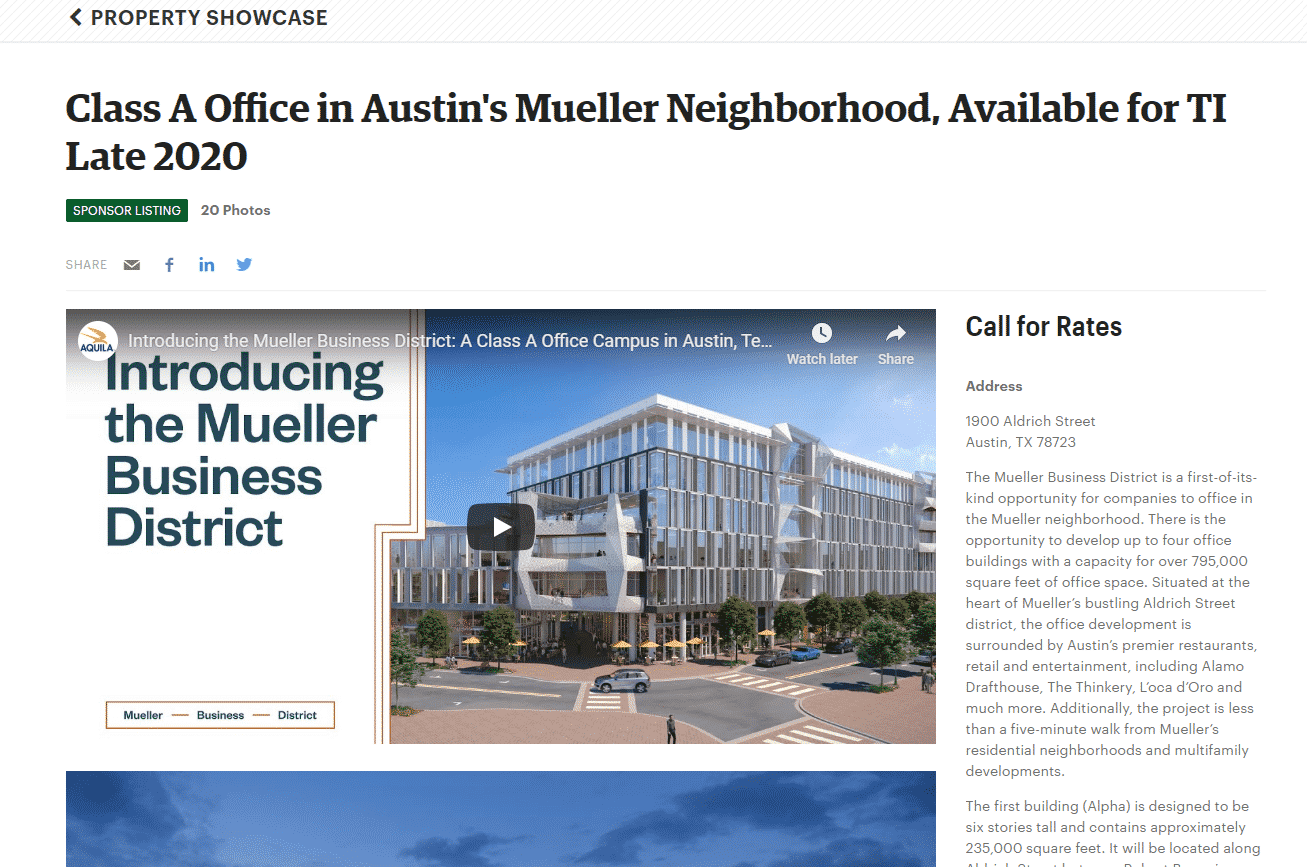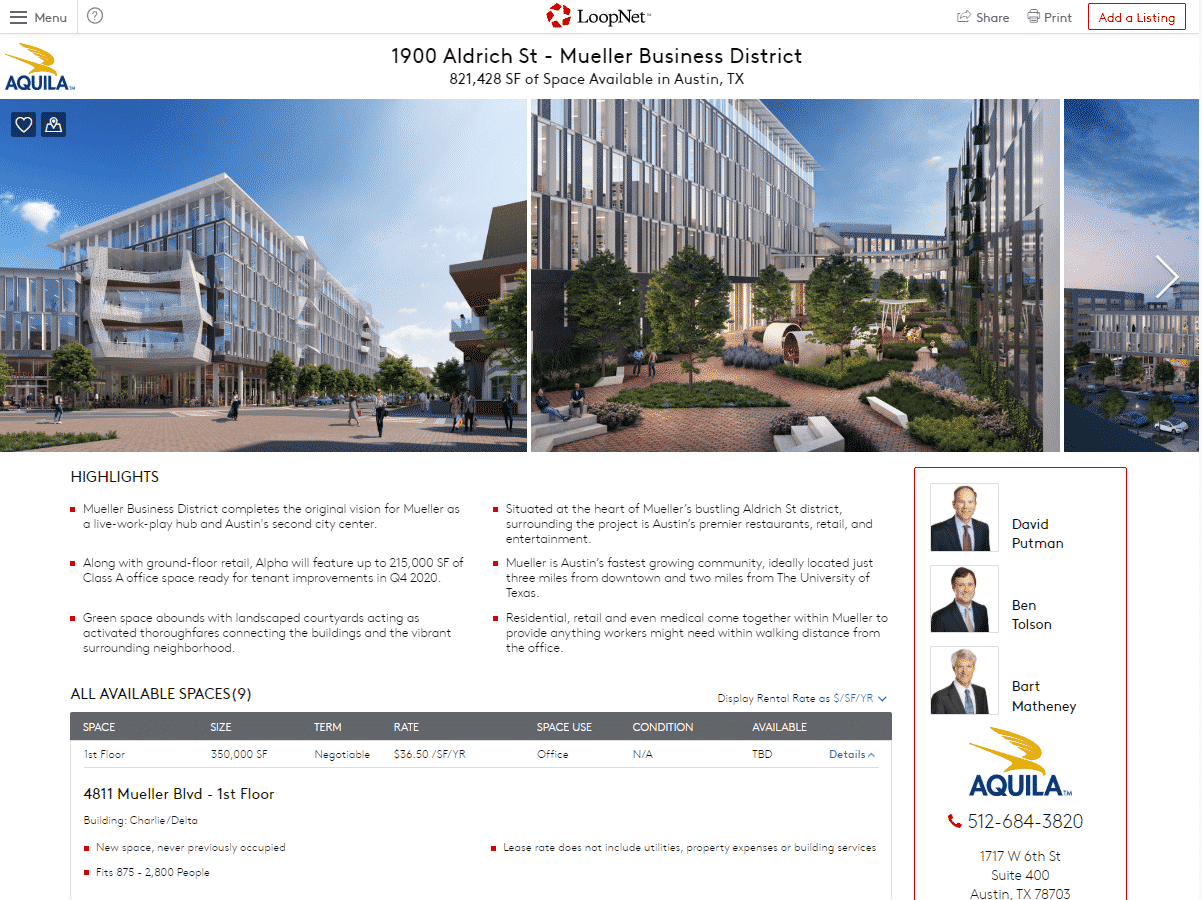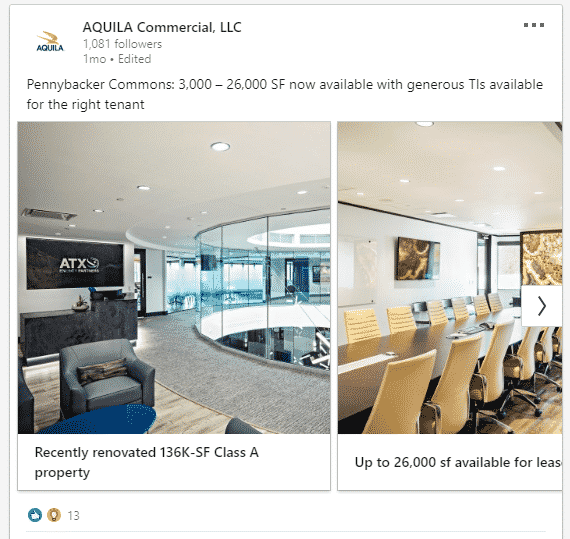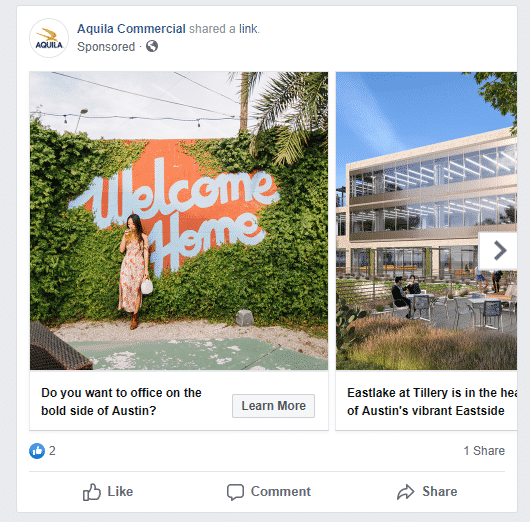If you own a large property or commercial development, it’s important that you have a strong marketing strategy in place. Along with basic marketing materials, video, branding, and a property website, you should also consider investing in advertisements for your property.
Read Next: The Ultimate Guide to Commercial Real Estate Marketing
While you might think of an advertisement as a print ad in a magazine or newspaper, today’s ads can come in many forms from traditional ads as mentioned previously to sponsorships or even social media advertising. The method that you choose will depend on who your audience is, how they behave, and how much you have in your budget to dedicate to advertising.
The advertising “rule of 7” states that someone must see or hear something seven times before they make a purchase. Because of this, the main goal of commercial real estate advertising is awareness and brand building. Seeing your branded property across different platforms or mediums is the best way to get someone to remember it.
At AQUILA, we have worked on many advertising campaigns for large commercial properties and developments. Over the course of these campaigns, we have learned what types of advertisements are the most impactful and how to overcome the obstacles related to each type of ad.
In this article, we will lay out the basics of advertising your commercial property including:
- Types of advertisements to consider
- Estimated costs
- How to measure results
- Where you should advertise
Traditional Advertisements & Sponsorship Opportunities
Newspapers and Business Journals
Newspapers and business journals might be the first thing you think of when it comes to traditional advertising. These can be useful for businesses targeting a particular location or industry.
For example, you can place advertisements in local publications. In Austin, this might include the Austin American Statesman or the Austin Business Journal. Typically, general city newspapers have a broad audience and readership, while business journals are targeted specifically at local decision-makers, business owners, real estate professionals and the like. Because of this, it may make more sense for you to advertise in business journals. These types of publications usually also offer packages that include ads in the print and digital versions of their publication.

Advertisement for Mueller Business District on the Austin Business Journal website.
The cost to advertise with newspapers and business journals will depend on the type of publication, size of the audience and the package you choose. They may also have the option to include display ads, sponsored content on their website or more options in their more extensive and expensive packages.
Trade Publications
Trade publications can be a great place to run ads if you’re trying to get your property in front of a certain sector of your targeted audience.
For example, if you’re targeting tenant representation brokers, you may target real estate publications like GlobeSt, Bisnow and Real Estate Business. These publications are broadly read by and target the commercial real estate industry. It’s important to find out which trade publications are most popular in your intended market and sector before you choose where to place your ad. These types of publications can usually offer varying ads such as sponsored content, newsletter placements, display ads and more.
Listing Sites
Advertising on commercial real estate listing sites, specifically CoStar and Loopnet, can be a very powerful way to target tenant representation brokers as well as tenants. CoStar is most valuable for targeting tenant rep brokers. It’s the first stop for most brokers when researching availabilities. However, it offers limited access as it requires a paid membership and is primarily used by brokers and other industry professionals.

Advertisement for Mueller Business District on Loopnet.
Loopnet, on the other hand, is valuable in targeting tenants directly. It is open to the public and allows you to reach decision-makers who are researching options presented by their tenant rep broker or who are looking to lease or buy space directly. More and more tenants are doing their own research before they contact a broker or after the broker has presented them with options, so advertising on Loopnet can be very valuable.
With both sites, you can target by city or market to further zero in on a specific audience.
The cost of advertising on listing sites is usually broken down into tiers. Generally, the more you pay the more people will see your ad. They also may require you to commit to a minimum number of months.
AQUILA Pro Tip
What if you commit to a six-month advertising contract and your space gets leased before the contract ends? Or what if you only have enough in a property’s budget for a three-month ad?
Before signing the contract, ask if you can substitute in different properties over the life of your contract. This way you can split the cost between properties and avoid paying for an ad you don’t need.
Sponsorship Packages
Purchasing sponsorship packages with prominent organizations is another way to get your property in front of the eyes of a specific group of people. The organizations you choose to work with will vary by location but commercial brokerage associations are a good place to start.
In Austin, you might consider organizations such as the ULI (Urban Land Institute), CBA (Commercial Brokers Association) and RECA (Real Estate Council of Austin) that are made up of industry professionals.
If you’re looking to target tenants directly, you might target local industry organizations like the Austin Tech Happy Hour. We suggest seeking out chapters of these organizations in your city or similar organizations. These types of organizations will let you target tenant rep brokers or specific tenants in your market.
Sponsorship packages usually include advertising opportunities at events and may also include traditional ads in their publications, display ads on their website, or recognition in their email newsletters. Promotional opportunities at events may range from logo display on various material to activations or booths at the event.
The cost for a sponsorship package depends on the organization and the level of sponsorship package you choose. These organizations will likely have media kits readily available to send you information about their specific sponsorship options and audience if you ask.
Events
Sponsoring events can also be an effective way to advertise. For example, in 2020 AQUILA’s client chose to sponsor BisNow’s Austin State of the Market on behalf of its building Preserve at 620. This meant that the event would be held at the sponsoring property, drawing hundreds of industry professionals out to the newly completed project to see the space first-hand.

Bisnow’s Austin State of the Market at Preserve at 620.
You can also sponsor smaller events in your community. This can be a great way to build goodwill with the neighborhood and to connect with local business owners and decision-makers. Events like this usually allow you to set up a booth, hand out collateral and speak with attendees. For example, AQUILA’s Mueller Business District team participated in Mueller’s 2019 Aldrich Street Fair. This not only helped the team get involved in the Mueller community but also helped us promote the Mueller Business District. The event allowed us to reach an audience face-to-face rather than through a screen or in a publication.
Additionally, the organizations mentioned above as sponsorship opportunities may also offer specific event sponsorships. In Austin, it is common for developers to sponsor CBA events – their annual golf tournament and real estate challenge – to promote new developments. This is a great, and usually somewhat affordable, way to get in front of the commercial real estate community.
The cost of sponsoring an event can vary wildly. It all depends on the scale of the event, the location, the audience size and more. If an event is larger or more high-profile, it will typically be more expensive. But, even smaller events with the right audience can have a large impact.
How to Measure Traditional Ad Results
When it comes to traditional advertising and sponsorships, it can be hard to measure results and tie them directly to a deal. You can note the number of people who approach your booth at an event or you may receive calls from leads that mention an ad in a specific publication, but overall, it will be hard to track.
If you choose to advertise on a listing site, you will get more trackable metrics. For instance, on Loopnet, you can see the number of impressions your ad received (the number of times your listing is shown in search results), detailed views (how many times your listing was clicked on), and visitor details like the company who viewed your listing, where they are located, and how many times they viewed your ad. This can be valuable information when deciding who to reach out to or send more information to.
Different trade groups and business journals will be able to provide you with different insights into your audience. Depending on what information they have about their subscribers and viewership, they may be able to share demographic information with you for your audience, including company name, job titles, etc. They will likely also be able to share information like page views, click-through rates, etc.
While these details may not provide direct insights into revenue generated from these ads, it can still provide valuable insights about who is seeing your ads, cost per impression and more.
While the results may be hard to track, traditional ads will help keep your property top-of-mind for your audience and reach large audiences that you may not be able to reach in other ways.
How Much Does it Cost to Advertise A Commercial Property With Traditional Advertisements?
Ultimately, it depends. Generally, the longer your campaign, the more expensive it will be across all ad types. Additionally, when you are targeting people that are further along in the buyer’s journey, it tends to be more expensive.
Typically, with these advertising methods, there are tiered systems. To get the highest level of exposure, it will cost more. From being the title sponsor at an event to a platinum-level advertiser online, typically these types of packages will get the best placement and the most promotion and also come at the highest cost.
It is up to you to evaluate the cost and promotion associated with each level of sponsorship to see what makes sense for your property.
To give an estimate, annual sponsorships can be anywhere from $2,000 to $10,000+ depending on the organization and level of sponsorship. Event sponsorships can range from a few hundred dollars to tens of thousands of dollars, depending on the scope, scale, audience, host, etc.
Reach out to the publication or organization that you would like to advertise with to get exact prices on their advertising packages.
Read Next: How Much Does It Cost to Market a Commercial Property?
Social Advertisements for Commercial Property
LinkedIn is known as the best social site to advertise on for business-to-business companies.
Because this social network is business-oriented, when users see ads they are already in a professional mindset.
LinkedIn ads are valuable because it gives you the most targeting options of any social advertising platform. On LinkedIn, you can target by company, industry, company size, job title, job seniority, location and so much more. Rather than a scattershot approach, LinkedIn’s targeting allows you to zero in on the exact audience you want to get your building in front of – be it c-suite executives at tech companies in San Francisco or tenant representation brokers at commercial real estate firms in Austin. When your ads are highly targeted, you are more likely to reach the people you want. And more importantly – if you’re targeting the right people – they’ll find your ads interesting and be more likely to click.

An example of a LinkedIn carousel ad AQUILA recently ran for Pennybacker Commons.
But, this great advertising platform comes at a high price. LinkedIn is the most expensive social network to advertise on. According to AdStage’s 4Q 2019 Benchmark Report, LinkedIn’s average cost-per-click (CPC) is $4.08, but it can reach much higher costs than this as different industries have different averages. The general rule of thumb is to only use LinkedIn when you are selling/promoting products and services with very high value. Commercial real estate definitely fits into this category.
Read Now: 4 Benefits of Professional Photography for Commercial Real Estate
Facebook/Instagram
Facebook and Instagram ads are both managed and created on the Facebook Ads platform. While these ads are, as a rule, cheaper than LinkedIn, the targeting capabilities leave something to be desired.

A Facebook/Instagram carousel ad we recently ran for Eastlake at Tillery.
Because of changes in recent years, Facebook does not offer as many options when it comes to targeting. But, while it’s harder to target your audience, it’s also cheaper. Facebook’s less expensive ads let you cast a wider net and get more clicks at a lower cost. Once again taken from AdStage’s 4Q 2019 report, Facebook’s average CPC is $0.81.
A pitfall with the Facebook ads platform is the approval process. Ads can take up to 72 hours to be approved, and when advertising a commercial property, it’s common for the ad to be flagged as a housing opportunity advertisement. Ads that are related to credit, employment or housing are beholden to more stringent advertising rules. Commercial real estate does not fall into this category, but it can be difficult for the algorithm (and sometimes the human auditors) to know the difference, making the approval process a somewhat challenging one.
Is your commercial real estate ad getting rejected?
An issue that I have personally run into is Facebook’s algorithm automatically flagging most property ads as a special category housing ad. This limits your targeting options even more. We recommend repeatedly appealing your disapproved ad until it reaches an actual reviewer (instead of a bot). Can’t find where to appeal an ad? We couldn’t either until we found this hidden link that allows you to appeal disapproved ads even if you haven’t changed the copy. Once a decision is made on your ad, you will receive a message in your support inbox.
AQUILA Pro Tip
If your goal is to drive traffic to your property website or listing, on Facebook we recommend optimizing for landing page views rather than clicks. This ensures that your audience is actually seeing your webpage and not just accidentally clicking a link or not waiting for the website to load.
Ultimately, Facebook is a cheaper way to advertise online. You may not be reaching the highly-targeted audience you wish for, but if you cast a wide enough net in the right direction, you should be able to reach them since your advertising spend will go a lot further.
Realty Ads
RealtyAds has become a staple tool for property marketing in the Austin market. The platform uses a proprietary algorithm to target prospects and brokers across multiple platforms including social media and Google Ads.
The advantage here is that you can cover multiple platforms in one place, and you can tinker as much as you like or you can use it as more of a set-it-and-forget-it option.
How to Measure Social Ad Results
Measuring results can be difficult when advertising for commercial real estate. With normal e-commerce ads, ads can be tied to conversion such as a sale. Most commercial real estate deals take a long time and go through many different offline steps before a deal is complete. Because of this, it can be hard to measure conversions and tie them directly to revenue. This is why we recommend going into a social advertising campaign with the goal of keeping your property top-of-mind for your audience rather than wanting to make a sale directly through your ads.
On Facebook, if your main goal is to drive traffic to your website (which we recommend starting out with), you should be paying close attention to landing page views and frequency. Also, if you are running video ads, note the video average play time.
Frequency refers to the average number of times each person in your audience saw your ad. With the “rule of 7” in mind, we recommend aiming for a frequency of seven or more on Facebook.
AQUILA Pro Tip
Make sure you install your Facebook “Pixel” and LinkedIn “Insight Tag” codes on your property website so you can retarget people who visit the site.
When looking at results on LinkedIn, you will have more data about your audience than with Facebook. You should note website visits and click-through-rates as usual but you should also utilize the demographics charts that LinkedIn provides. In these charts, you will see details about the people who engaged with your ad, including company names, job titles, industry, company size, and more. If you are running a video ad you can also see these demographics for the people who watched the entire video. Knowing who took the time to actually look at the ad and watch your video is valuable information.
Read Now: 7 Videos You Should Be Using to Market Your Commercial Real Estate Property (Examples)
There are countless other metrics you can track on these platforms, but these are the basics for any beginner.
How Much Does it Cost to Advertise A Commercial Property With Social Advertisements?
The cost of running advertisements on social media depends on a number of things, including:
- How many people you want to reach
- How many ads you want to run
- How targeted your campaigns are
- How long you want the ad to run
- How many times you want each person to see it
- And much more
Obviously, deciding how much to spend is a complex issue and will also depend on how much room you have in your advertising budget and how much you want to spend on advertisements elsewhere.
Once you know your target audience and campaign length, you can test it in the ad platform to see how much your desired results will cost. Raising and lowering your budget and expanding or refining your audience will affect the predicted results, so it can be helpful to play around with this before deciding on your budget.
If you want to start running social ads for commercial real estate in Austin, we recommend you begin by spending at least $200 per ad on Facebook and $500 per ad on LinkedIn per month. To begin, we recommend running a campaign targeting tenants and a campaign targeting tenant rep brokers for each property on each social platform.
Where Should You Advertise Your Commercial Property?
here you choose to place your advertisements ultimately depends on your target audience, the sales cycle stage, and your budget.
Audience
Newspapers are going to have a drastically different audience than commercial listing sites, and LinkedIn and Facebook are generally used by different groups of people with significantly different intent (business versus play), but this doesn’t mean that one platform is right and one is wrong.
In order to craft the most accurate and effective target audience, you should talk with the brokers at your firm. They will likely know who they want to target based on geographic location, company, industry, sales cycle stage or any other criteria.
Most publications will give you stats about the demographics of their readership, and social ads allow you to target exactly who you want with demographics and geographic targeting. Once you determine who your target audience is, it should be easier for you to decide where you should advertise.
You should also take geographic targeting into consideration. When you advertise with a local publication, you will likely only reach local audiences. When you advertise on social media, you can pick and choose what locations you want your ad to show in. For Austin, if you only advertise locally, you risk missing out on getting in front of the many companies looking to expand into or relocate to Austin. Consider also targeting the markets where Austin tenants tend to relocate from to make sure you aren’t leaving important prospects out.
Donor Markets: Cities or regions that are home to companies that are likely to expand into or relocate to your property’s market. For example, San Francisco and Silicon Valley are considered prominent donor markets for Austin.
Sales Cycle Stages
Awareness-Level Advertising
At this stage, your goal is to make sure the market knows about your property and the opportunity that it presents.
Your goal is to make sure your property is in front of the brokerage community, industry players, the city and chamber of commerce, and business decision-makers (CEOs, CFOs, Real Estate Directors, etc.) both in your market and any potential “donor markets.”
This is the widest point of the funnel and what we might call the “scattershot” portion of your advertising campaign. You want to make sure everyone who should know about your property, does.
Awareness ads are particularly relevant when timed to coincide with major milestones, such as permitting, groundbreaking and delivery. Rather than spending funds throughout the construction and lease-up of your property, we recommend focusing on shorter, one-to-three-month campaigns that coincide with these milestones.
There are platforms we recommend for the awareness stage of your campaign:
- Industry or trade publications
- Business Journals
- Broker-focused LinkedIn ads
- Realty Ads
- Events
- Sponsorships
Consideration-Level Advertising
Once you’ve cast your wide net and the market is aware of the opportunity, it’s time to narrow in on your targeted list of prospects.
In this phase, your goal is to get your property in front of the decision-makers at companies who are actively looking for space like yours.
These prospects should include tenants who are known to be in the market or who meet a certain set of parameters (size, lease expiration date, recent funding, etc.) to be considered good prospects for the space.
Commercial real estate used to be a world of brokers talking to brokers. These days, the company decision-makers are doing their research online. This is your opportunity to reach these decision-makers directly and put your property at the top of their mind.
There are platforms we recommend for the consideration stage of your campaign:
- Company-focused social media ads
- Costar/LoopNet
Decision-Level Advertising
Finally, once you’ve made contact with a prospect and have them in your sights, it’s time for decision-stage ads.
If awareness is a shotgun approach, this is a sniper campaign. Your focus here is to get in front of a specific group of people.
For decision-level advertising, we recommend using prospect-focused social ads.
In this case, you’re taking the social advertising strategies we’ve discussed before and honing in on just the decision-makers at one or two companies.
We suggest running these in the period of time leading up to and right after a meeting or a pitch. You want them thinking, “wow, since I learned about this property I just keep seeing it everywhere.” You want to be front and center in their minds and on the tip of their tongue as they’re having these conversations in the boardroom, around the water cooler, or via Zoom.
Cost
After you decide who your audience is, you should also consider the cost associated with your ideal platform. Some ads are going to be much more expensive than others and you need to decide on your budget before you decide where you want to spend your money. Each advertising platform will offer varying packages for ads depending on your needs – you should reach out to the specific platform you’re interested in and get a personalized quote.
After you know your audience and your cost, and the sales stage you should be able to choose the best platform for your advertisement.
Conclusion
Now that you have all of the information you need to start advertising your property, we encourage you to experiment with different platforms and mediums. This will help you decide what works best for your property.
We recommend coordinating with your leasing team before beginning any advertising campaign, as they will have insights and recommendations based on your specific property, market and target tenants.
Originally published March 2020, updated June 2022.
Inspired to see what else you can do to draw more attention to your commercial property? Check out these property marketing tips:
- Guide to Building an Effective Marketing Center for Your Commercial Property
- 6 Best Branding Agencies for Commercial Real Estate Property
- 8 Reasons Your Commercial Property Isn’t Leasing
- Broker Events for Property Marketing: Pros and Cons
- Should You Allow Tenants to Bring Dogs Into Your Office Building? (Pros & Cons)
Not pleased with the marketing and leasing efforts of your current brokerage firm? You want to consider hiring a new leasing team.














